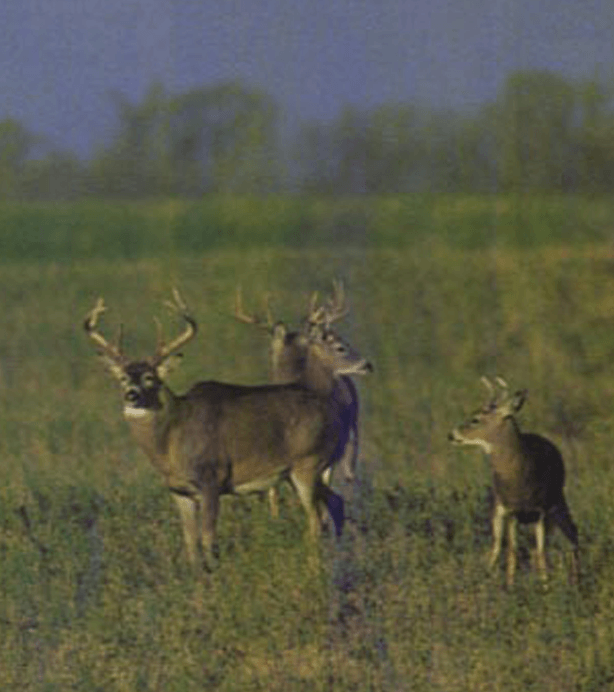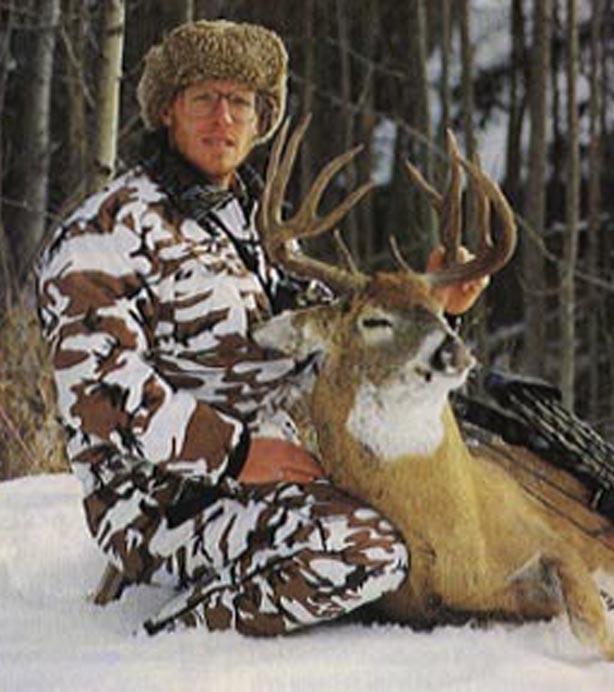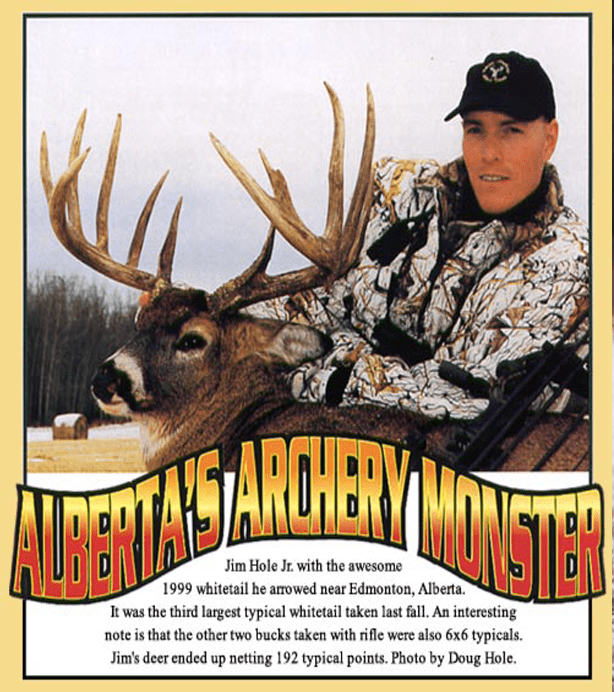You Shot The Little One!
by Mark T. Sullivan
(North American Whitetail, September, 2000)


As Jim Hole Jr. got out of his brother’s pickup truck last Nov. 29 and prepared for the hike to his stand, he couldn’t help thinking about the long, strange and yet remarkable bow season he’d already had.
Jim, an outfitter in the famed bow-only deer zone surrounding Edmonton, Alberta, had taken a bull moose and a nice mule deer buck with bow tackle back in October. And his clients had run up and unprecedented string of successful whitetail hunting, despite record heat and tough winds. Over the first four weeks of November they’d harvested 15 bucks, eight of which would make the minimum score for Pope and Young – including five 150-class deer and an eye-popping 10-pointer grossing around 180 points.
Despite all of this, Jim couldn’t have anticipated that he was about to rewrite the Alberta record book as he trudged across the cut barely field with his brother Doug on the next-to-last day of deer season.
Doug, on the other hand, was feeling confident that something very big was about to happen. He’d hunted the 2-mile by 2-mile area off and on for several weeks, but he had focused his efforts in one particular quarter-section to the northwest. He’d seen deer there, including several nice bucks, but not the sort of monsters he and his brother are known for. (See “The Hole Truth,” October 1999 Issue)
Then on Saturday, Nov. 27, the weather changed, bringing colder temperature and a skiff of snow. Doug jumped out of his tree stand early in order to scout. The tracks he saw in the snow that morning led him to put up and observation stand along the east side of a quarter-section about a mile to the southeast of where he’d been hunting. The stand allowed him to watch a good portion of a rolling field about 800 yards on a side. The field immediately in front of Doug had been plowed under. To his south about 400 yards we as large block of timber, which he figured was the major bedding area for deer using the field. About 300 yards directly west of his stand, the undulating terrain dropped into a wide slough bottom that bisected the greater field. The western edge of the bottom held a willow ringer about 125 yards long, beyond which lay but barely. The farmer had spread manure on the stubble immediately adjoining the willows. Doug, a civil engineer and medical-equipment entrepreneur, had taken some incredible deer with his bow, including 170-class and 180-class 10-pointers, but what he saw that evening left him breathless.
“I’d been in the stand about an hour and had seen a lot of deer activity, mostly does and small bucks moving from the bedding area to the south of me,” Doug says. “I could see three does in the willows, which I figured for a travel corridor from the main bedding to several smaller bedding areas to the north. And then, all of a sudden, I see these two huge – bucks, both typicals, come into the picture and start chasing the does around.
“I watched them for a good while in broad daylight,” he continues. “The smaller one, a 6×6, I figured would go in the 190s Pope and Young. The other one was straight 7×7 I figured would score around 210 as a typical. I mean, both of them are world-class monsters, but one’s got to be pushing the world record, eh?”
Doug went home that night and described to his younger brother what he’d seen, using an aerial photo of the quarter-section to explain the situation. At the southern end of the willows where he’d seen the two monsters stood two thin poplars. If Jim was game, Doug said, he’d put a stand one of the trees and a second stand about 125 yards to the north in the thickest part of the willow bottom.
After four weeks of guiding, Jim had some pretty good ideas about where he’d like to be spending the last two days of the season, so he was reluctant to follow his brother’s advice and hunt the field on Monday afternoon.
“But Doug kept telling me the setup was awesome,” Jim says. “I’d never seen him so certain, so I agreed to give it at try.”
On Sunday the wind wasn’t right to put up the stand, so Doug waited to enter the area until after lunch on Monday, when the wind changed to the west-southwest. The Holes use a “pin” tree-stand system of Jim’s design that allows them great flexibility when hunting. Doug put up two pins and went to meet Jim, who was returning from the airport after dropping off his last client of the year.
The brothers entered the giant field from its southwestern corner. Fifty yards into the cut barely, Jim demanded they stop to spray the bottoms of their boots with
“Cover Up,” a vanilla-based product they use to conceal their entry from prowling bucks. Then, concerned that any deer bedded in the timber to their east might spot them, they stayed in a low spot in the field to work their way northeast toward the willows.
When the brothers were roughly at the midpoint of the willow thicket, they split up. Doug proceeded north to the densest portion of the willows, while Jim hooked south.
The stand Doug had chosen for Jim faced due south, allowing an unfettered view of the northern and western edges of the primary bedding area some 300 yards away.
“I got up in the tree, popped in the stand, turned around and immediately knew why Doug had put me there,” Jim says. “The area was ripped with deer sign. There was a heavily used trail within five yards of the base of my tree. There was another trail 10 yards to the east in the slough glass and a third 25 yards beyond that, all of them heading off toward that primary bedding area.”
But there was a problem. Jim’s 6 feet 2 inches tall and over 200 pounds, and the tree he was in was so thin it couldn’t break up his silhouette. Worse yet, every time he moved, the tree shook.
“I remember thinking, This is a great spot, but a lousy tree. I’ve got to draw early, so the deer don’t pick up my skylined movement in the shooting lanes and bolt,” Jim says. “Once I figured that out, I pulled out my clippers and began cutting enough branches to let me take the shots I felt were possible. I knew I was taking a risk, because the first 40 yards of timber off in the bedding area were relatively open. The buck could have been watching me the whole time, but I had to take the chance.”
By the time Jim finished trimming twigs and getting his gear organized, it was after 4pm. Within 10 minutes, he saw a doe appear along the west edge of the bedding area. The undulating terrain allowed him to see her only intermittently as she worked northwest toward a circle of willows about 400 yards from Jim. Then he looked to his northeast and saw a second doe moving west along a hedgerow.
“Doug told me he expected the bucks to come from the south, but seeing these two deer enlightened me to the fact that I’d better be watching in all directions, and I’d better be standing up the rest of the hunt,” Jim says.
Another 10 minutes passed, the light started to get dim. Jim saw a third doe appear to his northwest; then a buck emerged from the western edge of the bedding area, head down, bird-dogging in all directions, cruising for a hot doe. The 130-class 10-pointer soon passed Jim’s stand at 80 yards.
“The way he was moving I knew he was susceptible to calling, but given what Doug had described, I decided I’d better wait and take my chances that one of the big bucks would show,” says the 36-year-old outfitter.
Ten minutes later, at 4:25, the sun set. At 4:30, Jim decided to rattle. He started lightly, in case there was a deer he couldn’t see in the nearby willows. He increased the tempo to 80 percent volume, then finished by crashing the beams together twice. The sequence took no longer than 20 seconds.
From the way he was standing, Jim could shoot through lanes to his west, southwest, south and east without moving his feet. Within five minutes he heard the crunch of approaching footsteps, and then he caught movement to his southwest. Something was coming up through a low spot from the direction of that circle of willows where the first doe had disappeared. Jim got the binoculars on the deer and saw the high, wide frame of a buck.
“I knew he was a very good typical and though he’s got to be one of the ones Doug had seen the other night,” Jim says. “But beyond that, I wasn’t thinking about how big he was, just that he was a definite shooter, and I had to concentrate on executing the plan.”
The buck kept moving, eventually getting 35 yards to the southeast of the stand, where he was but a few steps from leaving bow range entirely. For a moment Jim considered letting his bow down and grunting to the buck, but he figured that if he did, the deer would pinpoint his position and spot him in the tree.
Fortunately, the buck decided to turn at that point and travel north toward a wide shooting lane east of Jim’s perch. The buck eased out from behind some willows as he walked toward a spot where snow had matted down the grass. Jim, still at full draw, twice grunted with his mouth to stop the monarch, but the buck didn’t hear the calls and moved straight through the snow patch without stopping to offer a clear shot.
“He was back in the high slough grass, almost due east of me now and headed toward my scent stream,” Jim says. “There was a second patch of snow directly in him path, about 32 yards from me, and I knew I had to stop him in it, or the game was over.
“Just as he hit the snow, I made this loud ‘eeegh’ sound, and he froze broadside,” the bowhunter continues. “I wasn’t sure if he was looking at me or the base of the tree, but he was locked in on my direction for sure.
“I’d been shooting consistently all summer and fall, so even through I’d been at full draw for 40 seconds, I still felt strong,” Jim says. “I held my 25-yard pin on him, about a quarter of the way down from his spine, knowing he was about 30 to 35 yards away. I had both my eyes open and squeezed the release. The bow fired, and I heard what sounded like a perfect hit, and then the sound of grass being cut.”
The huge deer took a lunging stop forward, hesitated, then bolted straight north about 90 yards before button-hooking out of sight into the willows.
Only 125 yards away, Doug was in al tree in the thickest part of the willows, watching a single trail. He heard the shot and the sound of a deer running, so he stood and drew his bow, expecting to cast an arrow if the buck trotted through his shooting lane. But before the deer reached him, Doug heard it fall, cough and then go silent.
“I just knew he’d gotten one of the big ones,” Doug says. “So I came right down out of my tree.”
Only 10 minutes later, the brothers found the huge 6×6 lying at the edge of the willows.
“It was one of those overwhelming feeling seeing him there,” Jim recalls. “He went from being a 160-class to a 170, to, oh man, he’s probably a 180. It wasn’t until we got home and put the rack of Doug’s 180-class 10-pointer inside the frame of this rack that it started to hit home that we’d taken a world-class buck.”
The brothers rough-scored the deer at 195 the next morning and then had their friend and fellow archery outfitter Ryk Visscher, come over to tape the buck. Visscher, an official measurer for Pope and Young and Boone and Crockett, green-scored the deer at 199 gross, 193 net typical.
“Then second you see the buck’s rack you know it’s a Boone and Crockett-quality animal, instantly at least 170 class,” Ryk says. “Then you notice the 6th points (G-5’s) and the length of all the tines and the beams, and you know the score’s going to go way up there.”
Of the two antlers, the left is more impressive; that antler alone scores 91 2/8 inches. If the right side matched it perfectly, the deer would net 204 as a typical, just a half-inch under Mel Johnson’s all-time bow record form Illinois. The Johnson buck was shot 35 years ago.
After subtracting 6 1/8 inches in deductions, Jim’s deer ranks No. 2 all-time among Alberta bow bucks, right behind friend Don McGarvey’s wide monster from Edmonton’s bow zone. (That buck, which was shot in 1991, was featured in the December 1992 issue.)
Don’s outstanding deer had been panel-measured by the Boone and Crocket Club at 199 3/8 net points, a score that would rank it No. 2 all-time in P&Y. But when P&Y panel-measured the rack, that organization came up with more deductions than B&C did. As a result, Don’s buck received a final P&Y score of 197 1/8, ranking him No. 4 all-time by bow. Lloyd Goad’s 1962 buck form Iowa and Curt Van Lith’s 1986 buck form Minnesota remain tied for No. 2 in P&Y’s listings at 197 6/8 net points.
Even in Alberta, which is famous for world-class bucks, Jim’s is exceptional – and not just as a bow kill. He ranks No. 5 among all typicals ever taken in the province; in fact, he’s among the all-time top 70 in B&C’s records for North America, including gun kills and picked-up racks.
At present, it’s doubtful the Hole buck will be accepted into the P&Y records, as Jim as using a Mathews Solocam bow with more than 65 percent let off. P&Y rules preclude accepting trophies taken with such high-letoff bows, though they comply fully with provincial bowhunting regulations.
If the 65 percent letoff rule weren’t in effect, Jim’s buck likely would rank among the top 12 typicals in P&Y history. Ryk says he thinks the policy against high-letoff bows is unfair, and he’d like to see it changed. But Jim, for his part, says getting the deer into P&Y doesn’t matter that much to him.
“What’s important is the even and how it unfolded and the fact that the opportunity was created not by me, but by my brother,” he notes. “I was forced to see the game form my clients’ perspective. I was put into a stand by someone else, and my job was to execute his plan. When I think about it all, it kind of stuns me how Doug totally called it and described to me beforehand almost exactly what was going to happen. This would not have happened without Doug,”
And what of that 210-class typical Doug saw running with Jim’s monster? At a Christmas party last December, the landowner told one of the brothers he’d seen the superbuck browsing in his yard after season’s end. Seems these guys have something to look forward to this season as well.



